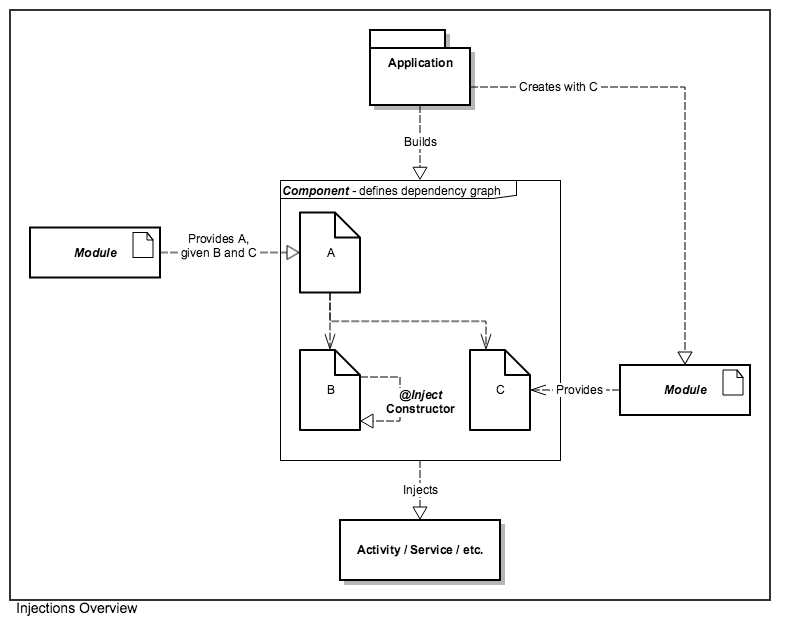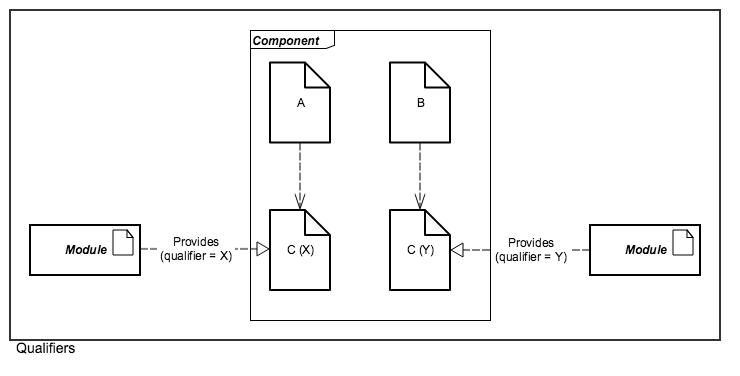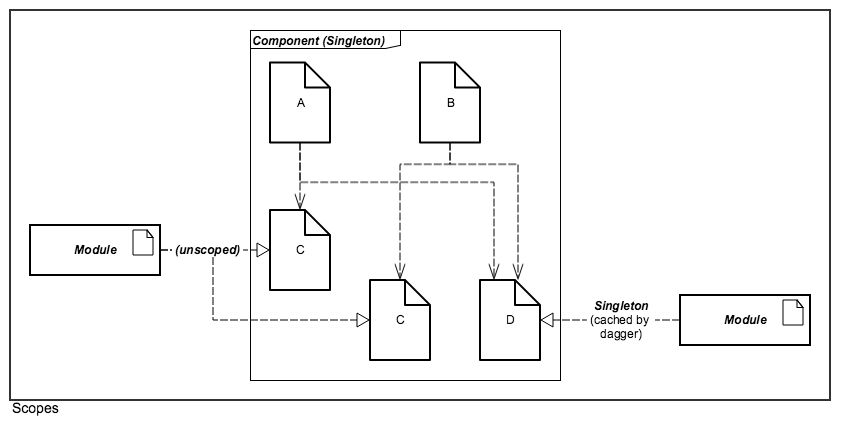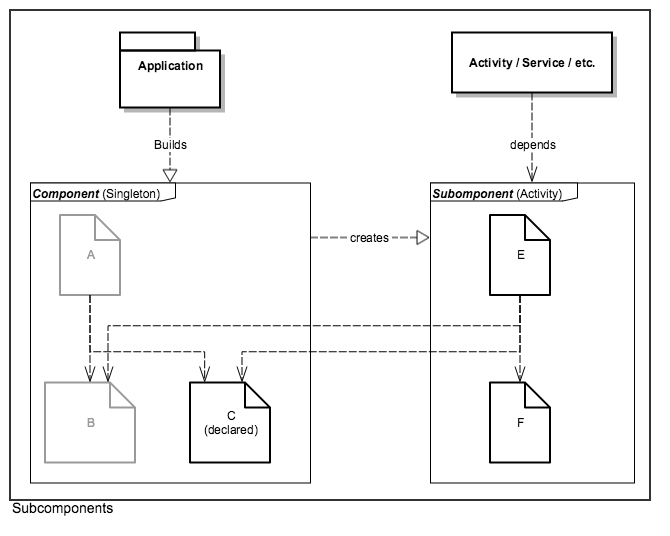Dependency Injection with Dagger 2 - TechGeekD/android_guides GitHub Wiki
Many Android apps rely on instantiating objects that often require other dependencies. For instance, a Twitter API client may be built using a networking library such as Retrofit. To use this library, you might also need to add parsing libraries such as Gson. In addition, classes that implement authentication or caching may require accessing shared preferences or other common storage, requiring instantiating them first and creating an inherent dependency chain.
Dagger 2 analyzes these dependencies for you and generates code to help wire them together. While there are other Java dependency injection frameworks, many of them suffered limitations in relying on XML, required validating dependency issues at run-time, or incurred performance penalties during startup. Dagger 2 relies purely on using Java annotation processors and compile-time checks to analyze and verify dependencies. It is considered to be one of the most efficient dependency injection frameworks built to date.
Here is a list of other advantages for using Dagger 2:
-
Simplifies access to shared instances. Just as the ButterKnife library makes it easier to define references to Views, event handlers, and resources, Dagger 2 provides a simply way to obtain references to shared instances. For instance, once we declare in Dagger our singleton instances such as
MyTwitterApiClientorSharedPreferences, we can declare fields with a simple@Injectannotation:
public class MainActivity extends Activity {
@Inject MyTwitterApiClient mTwitterApiClient;
@Inject SharedPreferences sharedPreferences;
public void onCreate(Bundle savedInstance) {
// assign singleton instances to fields
InjectorClass.inject(this);
} -
Easy configuration of complex dependencies. There is an implicit order in which your objects are often created. Dagger 2 walks through the dependency graph and generates code that is both easy to understand and trace, while also saving you from writing the large amount of of boilerplate code you would normally need to write by hand to obtain references and pass them to other objects as dependencies. It also helps simplify refactoring, since you can focus on what modules to build rather then focusing on the order in which they need to be created.
-
Easier unit and integration testing Because the dependency graph is created for us, we can easily swap out modules that make network responses and mock out this behavior.
-
Scoped instances Not only can you easily manage instances that can last the entire application lifecycle, you can also leverage Dagger 2 to define instances with shorter lifetimes (i.e. bound to a user session, activity lifecycle, etc.).
Android Studio by default will not recognize a lot of generated Dagger 2 code as legitimate classes, but adding the android-apt plugin will add these files into the IDE class path and enable you to have more visibility. Add this line to your root build.gradle:
dependencies {
// other classpath definitions here
classpath 'com.neenbedankt.gradle.plugins:android-apt:1.8'
}Then make sure to apply the plugin in your app/build.gradle:
// add after applying plugin: 'com.android.application'
apply plugin: 'com.neenbedankt.android-apt'Add these three lines to your app/build.gradle file after this apply statement:
dependencies {
// apt command comes from the android-apt plugin
apt 'com.google.dagger:dagger-compiler:2.0.2'
compile 'com.google.dagger:dagger:2.0.2'
provided 'org.glassfish:javax.annotation:10.0-b28'
}Note that the provided keyword refers to dependencies that are only needed at compilation. The Dagger compiler generates code that is used to create the dependency graph of the classes defined in your source code. These classes are added to the IDE class path during compilation. The apt keyword, which is provided with the android-apt plugin, does not add these classes to the class path, they are used only for annotation processing, which prevents accidentally referencing them.

The simplest example is to show how to centralize all your singleton creation with Dagger 2. Suppose you weren't using any type of dependency injection framework and wrote code in your Twitter client similar to the following:
OkHttpClient client = new OkHttpClient();
// Enable caching for OkHttp
int cacheSize = 10 * 1024 * 1024; // 10 MiB
Cache cache = new Cache(getApplication().getCacheDir(), cacheSize);
client.setCache(cache);
// Used for caching authentication tokens
SharedPreferences sharedPrefeences = PreferenceManager.getDefaultSharedPreferences(this);
// Instantiate Gson
Gson gson = new GsonBuilder().create();
GsonConverterFactory converterFactory = GsonConverterFactory.create(Gson);
// Build Retrofit
Retrofit retrofit = new Retrofit.Builder()
.baseUrl("https://api.github.com")
.addConverterFactory(converterFactory)
.client(client) // custom client
.build();You need to define what objects should be included as part of the dependency chain by creating a Dagger 2 module. For instance, if we wish to make a single Retrofit instance tied to the application lifecycle and available to all our activities and fragments, we first need to make Dagger aware that a Retrofit instance can be provided.
Because we wish to setup caching, we need an Application context. Our first Dagger module, AppModule.java, will be used to provide this reference. We will define a method annotated with @Provides that denotes to Dagger that this method is the constructor for the Application return type:
@Module
public class AppModule {
Application mApplication;
public AppModule(Application application) {
mApplication = application;
}
@Provides
@Singleton
Application providesApplication() {
return mApplication;
}
}We create a class called NetModule.java and annotate it with @Module to signal to Dagger to search within the available methods for possible instance providers.
The methods that will actually expose available return types should also be annotated with @Provides decorator. The Singleton annotation also signals to the Dagger compiler that the instance should be created only once in the application. In the following example, we are specifying SharedPreferences, Gson, Cache, OkHttpClient, and Retrofit as the return types that can be used as part of the dependency list.
@Module
public class NetModule {
String mBaseUrl;
// Constructor needs one parameter to instantiate.
public NetModule(String baseUrl) {
this.mBaseUrl = baseUrl;
}
// Dagger will only look for methods annotated with @Provides
@Provides
@Singleton
// Application reference must come from AppModule.class
SharedPreferences providesSharedPreferences(Application application) {
return PreferenceManager.getDefaultSharedPreferences(application);
}
@Provides
@Singleton
Cache provideOkHttpCache(Application application) {
int cacheSize = 10 * 1024 * 1024; // 10 MiB
Cache cache = new Cache(application.getCacheDir(), cacheSize);
return cache;
}
@Provides
@Singleton
Gson provideGson() {
GsonBuilder gsonBuilder = new GsonBuilder();
gsonBuilder.setFieldNamingPolicy(FieldNamingPolicy.LOWER_CASE_WITH_UNDERSCORES);
return gsonBuilder.create();
}
@Provides
@Singleton
OkHttpClient provideOkHttpClient(Cache cache) {
OkHttpClient client = new OkHttpClient();
client.setCache(cache);
return client;
}
@Provides
@Singleton
Retrofit provideRetrofit(Gson gson, OkHttpClient okHttpClient) {
Retrofit retrofit = new Retrofit.Builder()
.addConverterFactory(GsonConverterFactory.create(gson))
.baseUrl(mBaseUrl)
.client(okHttpClient)
.build();
return retrofit;
}
}Note that the method names (i.e. provideGson(), provideRetrofit(), etc) do not matter and can be named anything. The return type annotated with a @Provides decorator is used to associate this instantiation with any other modules of the same type. The @Singleton annotation is used to declare to Dagger to be only initialized only once during the entire lifecycle of the application.
A Retrofit instance depends both on a Gson and OkHttpClient instance, so we can define another method within the same class that takes these two types. The @Provides annotation and these two parameters in the method will cause Dagger to recognize that there is a dependency on Gson and OkHttpClient to build a Retrofit instance.
Dagger provides a way for the fields in your activities, fragments, or services to be assigned references simply by annotating the fields with an @Inject annotation and calling an inject() method. Calling inject() will cause Dagger 2 to locate the singletons in the dependency graph to try to find a matching return type. If it finds one, it assigns the references to the respective fields. For instance, in the example below, it will attempt to find a provider that returns MyTwitterApiClient and a SharedPreferences type:
public class MainActivity extends Activity {
@Inject MyTwitterApiClient mTwitterApiClient;
@Inject SharedPreferences sharedPreferences;
public void onCreate(Bundle savedInstance) {
// assign singleton instances to fields
InjectorClass.inject(this);
} The injector class used in Dagger 2 is called a component. It assigns references in our activities, services, or fragments to have access to singletons we earlier defined. We will need to annotate this class with a @Component declaration. Note that the activities, services, or fragments that will can be added should be declared in this class with individual inject() methods:
@Singleton
@Component(modules={AppModule.class, NetModule.class})
public interface NetComponent {
void inject(MainActivity activity);
// void inject(MyFragment fragment);
// void inject(MyService service);
}Note that base classes are not sufficient as injection targets. Dagger 2 relies on strongly typed classes, so you must specify explicitly which ones should be defined. (There are suggestions to workaround the issue, but the code to do so may be more complicated to trace than simply defining them.)
An important aspect of Dagger 2 is that the library generates code for classes annotated with the @Component interface. You can use a class prefixed with Dagger (i.e. DaggerTwitterApiComponent.java) that will be responsible for instantiating an instance of our dependency graph and using it to perform the injection work for fields annotated with @Inject. See the setup guide and make sure you've included the android-apt plugin. This plugin will allow you to better understand the code generated by Dagger 2.
We should do all this work within an Application class since these instances should be declared only once throughout the entire lifespan of the application:
public class MyApp extends Application {
private NetComponent mNetComponent;
@Override
public void onCreate() {
super.onCreate();
// Dagger%COMPONENT_NAME%
mNetComponent = DaggerNetComponent.builder()
// list of modules that are part of this component need to be created here too
.appModule(new AppModule(this)) // This also corresponds to the name of your module: %component_name%Module
.netModule(new NetModule("https://api.github.com"))
.build();
// If a Dagger 2 component does not have any constructor arguments for any of its modules,
// then we can use .create() as a shortcut instead:
// mAppComponent = com.codepath.dagger.components.DaggerNetComponent.create();
}
public NetComponent getNetComponent() {
return mNetComponent;
}
}Make sure to rebuild the project (in Android Studio, select Build > Rebuild Project) if you cannot reference the Dagger component.
Because we are overriding the default Application class, we also modify the appplication name to launch MyApp. This way your application will use this application class to handle the initial instantiation.
<application
android:allowBackup="true"
android:name=".MyApp">Within our activity, we simply need to get access to these components and call inject().
public class MyActivity extends Activity {
@Inject OkHttpClient mOkHttpClient;
@Inject SharedPreferences sharedPreferences;
public void onCreate(Bundle savedInstance) {
// assign singleton instances to fields
// We need to cast to `MyApp` in order to get the right method
((MyApp) getApplication()).getNetComponent()).inject(this);
} 
If we need two different objects of the same return type, we can use the @Named qualifier annotation. You will define it both it where you provide the singletons (@Provides annotation), and where you inject them (@Inject annotations):
@Provides @Named("cached")
@Singleton
OkHttpClient provideOkHttpClient(Cache cache) {
OkHttpClient client = new OkHttpClient();
client.setCache(cache);
}
@Provides @Named("non_cached") @Singleton
OkHttpClient provideOkHttpClient() {
OkHttpClient client = new OkHttpClient();
return client;
}Injection will also require these named annotations too:
@Inject @Named("cached") OkHttpClient client;
@Inject @Named("non_cached") OkHttpClient client2;@Named is a qualifier that is pre-defined by dagger, but you can create your own qualifier annotations as well:
@Qualifier
@Documented
@Retention(RUNTIME)
public @interface DefaultPreferences {
}
Scope annotations cause dagger to hold a single instance of the provided object in a given component. Provider methods that do not have a scope specified will be called to create a new object every time that the given type is injected.
@Singleton is a scope annotation that is defined by Dagger, but you can define any number of scope annotations in your application:
@Scope
@Documented
@Retention(value=RUNTIME)
public @interface MyActivityScope
The example above showed that we used singletons that lasted the entire lifecycle of the application. We also relied on one major Dagger component. If we wish to have multiple components that do not need to remain in memory all the time (i.e. components that are tied to the lifecycle of an activity or fragment, or even tied to when a user is signed-in), we can create dependent components. There are several considerations when using dependent components:
-
Two dependent components cannot share the same scope. For instance, two components cannot both be scoped to a
@Singletonannotation. This restriction is imposed because of reasons described here. Dependent components need to define their own scope. -
While Dagger 2 also enables the ability to create scoped instances, the responsibility rests on you to create and delete references that are consistent with the intended behavior. Dagger 2 does not know anything about the underlying implementation. See this Stack Overflow discussion for more details.
-
When creating dependent components, the parent component needs to explicitly expose the objects to downstream objects. For example, if a downstream component needed access to the
Retrofitinstance, it would need to explicitly expose it with the corresponding return type:
@Singleton
@Component(modules={AppModule.class, NetModule.class})
public interface NetComponent {
// downstream components need these exposed with the return type
// method name does not really matter
Retrofit retrofit();
}For instance, if we wish to use a dependent component created for the entire lifecycle of a user session signed into the application, we can define our own UserScope interface:
import java.lang.annotation.Retention;
import javax.inject.Scope;
@Scope
public @interface UserScope {
}We can then define a child component:
@UserScope // using the previously defined scope, note that @Singleton will not work
@Component(dependencies = NetComponent.class, modules = GitHubModule.class)
public interface GitHubComponent {
void inject(MainActivity activity);
}Let's assume this GitHub module simply returns back an API interface to the GitHub API:
@Module
public class GitHubModule {
public interface GitHubApiInterface {
@GET("/org/{orgName}/repos")
Call<ArrayList<Repository>> getRepository(@Path("orgName") String orgName);
}
@Provides
@UserScope // needs to be consistent with the component scope
public GitHubApiInterface providesGitHubInterface(Retrofit retrofit) {
return retrofit.create(GitHubApiInterface.class);
}
}In order for this GitHubModule.java to get access to the Retrofit instance, we need explicitly define them in the upstream component. If the downstream modules will be performing the injection, they should also be removed from the upstream components too:
@Singleton
@Component(modules={AppModule.class, NetModule.class})
public interface NetComponent {
// remove injection methods if downstream modules will perform injection
// downstream components need these exposed
Retrofit retrofit();
OkHttpClient okHttpClient();
SharedPreferences sharedPreferences();
}The final step is to use the GitHubComponent to perform the instantiation. This time, we first need to build the NetComponent and pass it into the constructor of the DaggerGitHubComponent builder:
NetComponent netComponent = DaggerNetComponent.builder()
.appModule(new AppModule(this))
.netModule(new NetModule("https://api.github.com"))
.build();
GitHubComponent gitHubComponent = DaggerGitHubComponent.builder()
.netComponent(mNetComponent)
.gitHubModule(new GitHubModule())
.build();See this example code for a working example.

Using Subcomponents is another way to extend the object graph of a component. Like components with dependencies, subcomponents have their own life-cycle and can be garbage collected when all references to the subcomponent are gone, and have the same scope restrictions.
The main differences from dependencies are that subcomponents:
- Need to be declared in the interface of the parent component.
- Can access all elements of the parent component's graph (not just ones declared in its interface).
Here's an example of using a sub-component for an activity:
@Module
public class MyActivityModule {
private final MyActivity activity;
public MyActivityModule(MyActivity activity) { this.activity = activity; }
@Provides @MyActivityScope @Named("my_list")
public ArrayAdapter providesMyListAdapter() {
return new ArrayAdapter<String>(activity, android.R.layout.my_list);
}
...
}
@MyActivityScope
@Subcomponent(modules={ MyActivityModule.class })
public interface MyActivitySubComponent {
@Named("my_list") ArrayAdapter myListAdapter();
}
@Singleton
@Component(modules={ ... })
public interface MyApplicationComponent {
MyActivitySubComponent newMyActivitySubcomponent(MyActivityModule activityModule);
}In the above example, a new instance of the subcomponent will be created every time that the newMyActivitySubcomponent() is called. To use the submodule to inject an activity:
public class MyActivity extends Activity {
@Inject ArrayAdapter arrayAdapter;
public void onCreate(Bundle savedInstance) {
// assign singleton instances to fields
// We need to cast to `MyApp` in order to get the right method
((MyApp) getApplication()).getApplicationComponent())
.newMyActivitySubcomponent(new MyActivityModule(this))
.inject(this);
}
}- Dagger 2 Github Page
- Sample project using Dagger 2
- Vince Mi's Codepath Meetup Dagger 2 Slides
- http://code.tutsplus.com/tutorials/dependency-injection-with-dagger-2-on-android--cms-23345
- Jake Wharton's Devoxx Dagger 2 Slides
- Jake Wharton's Devoxx Dagger 2 Talk
- Dagger 2 Google Developers Talk
- Dagger 1 to Dagger 2
- Tasting Dagger 2 on Android
- Dagger 2 Testing with Mockito
- Snorkeling with Dagger 2
- Dependency Injection in Java
- Component Dependency vs. Submodules in Dagger 2
- Dagger 2 Component Scopes Test